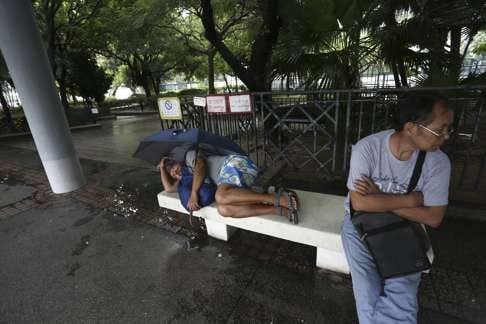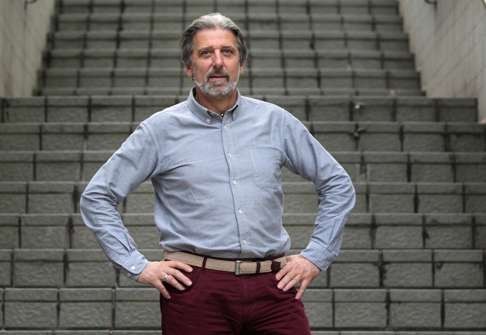
How Hong Kong’s hostile architecture hurts city’s homeless and poor
Life is already hard for the poor in Hong Kong, and the prevalence of hostile architecture designed to prevent street sleepers finding shelter is a reflection of uncaring official attitudes towards the needy
Each night Keung slept rough, usually on a park bench. It was hot and humid, and rats scurried around. To make matters worse, he had difficulty sleeping with his waist propped up by an armrest and his body arching back. He tried laying cardboard across the bench to soften the bump, but it was still uncomfortable.
City dwellers rarely give much thought to the armrests and metal dividers incorporated in the design of most public benches in Hong Kong, but for street sleepers like Keung, who died from cancer shortly after we spoke to him, they are a pain in the butt, literally.

Pang Pik-shan is a founding member of Light Up, a group of volunteers who conduct regular outreach activities serving the homeless, and has noticed many examples of unfriendly design in Hong Kong.
“Pavilions, which are supposed to provide shelter, have apertures in them. Benches are for people to rest on, but have metal dividers that prevent people from lying down. In the case of spaces under bridges, a lot of boulders or large planters are placed there,” Pang says.
So what is the purpose of these designs? “They are a silent way of keeping the homeless away. There’s no need to hire people to get rid of them. These installations and designs are used to let them know they are not welcome.”
The design features in public, semi-public or private spaces are not unique to Hong Kong. They are part of a wider urban design phenomenon known as “hostile architecture”, “defensive architecture” or, as Serbian architect and researcher Selena Savic calls it, “unpleasant design”.

The phenomenon is not new but has become increasingly pervasive globally, especially in modern cities. In London two years ago, 2.5cm-long metal studs installed on the ground outside a residential complex were removed after provoking public outrage.
More often than not, however, unpleasant design rarely raises eyebrows because it goes unnoticed by most of the community. “We simply wake up every day to new unpleasant installations around us and, quite often, we don’t even understand the ways in which they can be unpleasant to some people,” Savic says.
“These designs always target the marginalised, such as the homeless or skaters – people who don’t have much say in deciding what our common space should look like. This makes it a cruel, top-down approach to solving problems or sharing and maintaining common spaces.”
Hong Kong architect Bernard Lim Wan-fung says: “I wouldn’t call them designs. I’d say they are management tools.”
He says public space in Hong Kong is often designed from the perspective of those managing properties and spaces, whose priority is to maintain a sanitised environment. This creates a rigid urban design rather than an inclusive and user-friendly public landscape.
“The extent to which Hong Kong incorporates rules in its urban design is very rare … I can’t think of any other place that does the same – perhaps North Korea,” Lim says.

“We have a social obligation to provide a lot of seating in all spaces, to make them more public-friendly so people can hang out, talk to each other, meet each other. That makes the city ultimately work,” says Zimmerman. But unfortunately, from a management perspective, it’s preferable if people don’t loiter in public areas, he adds.
Although a sanitised environment may be beneficial to the community, Savic questions whether unpleasant design is appropriate. “In general, safe and clean places are probably nicer for most people. The problem is how do we get there? Do we drive people away? Does removing a sleeper from a bench really solve the problem for a person who strolls the streets looking for shelter?”
Hostile architectural designs may be silent, but they speak volumes about authorities’ attitude towards the homeless: out of sight, out of mind.
“Homelessness reflects a problem of poverty. Hong Kong has one of the highest levels of inequality in the world and a shortage of affordable housing; street sleepers often cannot afford the high rents and are forced to sleep on the streets,” Pang says.
“But the government never considers how to tackle poverty or housing issues. Instead, they view homeless people as a problem and try to keep them out of sight. Since they cannot outright chase them away from public spaces, they use administrative methods and manipulate urban design to send [the homeless] a message: that they are not allowed to stay there.”
Controversial measures such as fencing off areas under bridges or putting in place large boulders call into question the government’s policy, or lack thereof, on the issue of homelessness. And if hostile architectural design isn’t enough proof of the intention to keep these people out of sight, other steps clearly spell it out.

Although they have a timetable, allowing the homeless to clear their stuff in advance, cleaners sometimes appear unannounced, catching the street sleepers off guard. Such visits are suspected to be essentially raids to shoo them away. That’s how Keung lost what little he possessed in October last year, including pills to treat his cancer.
Making the streets uninhabitable and driving street sleepers from district to district does little to alleviate homelessness. If anything, it is counterproductive and makes life even more difficult for those struggling to get by.
Pang recalls an elderly man who decided to move off the streets into the only type of housing he could afford – a cage home for HK$3,300 a month. She was taken aback by the appalling conditions when she visited. “He’d simply moved from one hell to another,” Pang says.
According to figures released by the Census and Statistics Department, the number of street sleepers has been on the rise for the past five years. The Social Welfare Department registered 881 street sleepers in 2015, compared to 787 in 2014, although the official figures are believed to be the tip of the iceberg.
Pang blames the situation on an inadequate social safety net and a lack of effective intervention schemes. “The government has plenty of resources but fails to distribute them properly. Many homeless people contributed to society when they were younger, but descend into abject poverty when they grow old.
“Other people don’t understand and only see the outward manifestations, such as poor hygiene, the spread of disease and accumulation of rubbish. But ultimately, the homeless are the ones bearing the brunt of these problems.”
The government’s failure to address the issue, and the rise in the homeless population, feeds misconceptions about the destitute – for example, that street sleepers are lazy, dirty or drug abusers. It also raises tensions between the community and street sleepers.
“Some district councillors and legislators even frame homeless people as a threat to public safety for political gain,” Pang says, adding that this further reinforces negative stereotypes.
If there is any silver lining, more community initiatives are springing up in response, engendering greater care and compassion among the public for the less fortunate. Pang says the solution to the systemic injustice lies with the authorities.
“There is only so much citizens can do. When it comes to resource allocation and policymaking, the government needs to take responsibility. Otherwise, the homeless will only be caught in between.”
If you see any examples of #HostileArchitecture, take a photo and tag us @scmp_lifestyle

